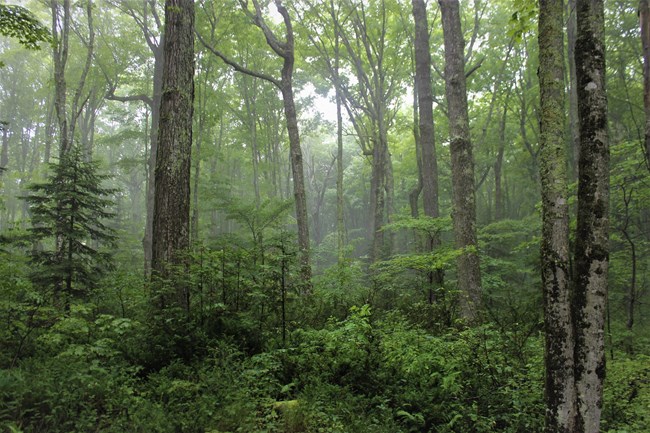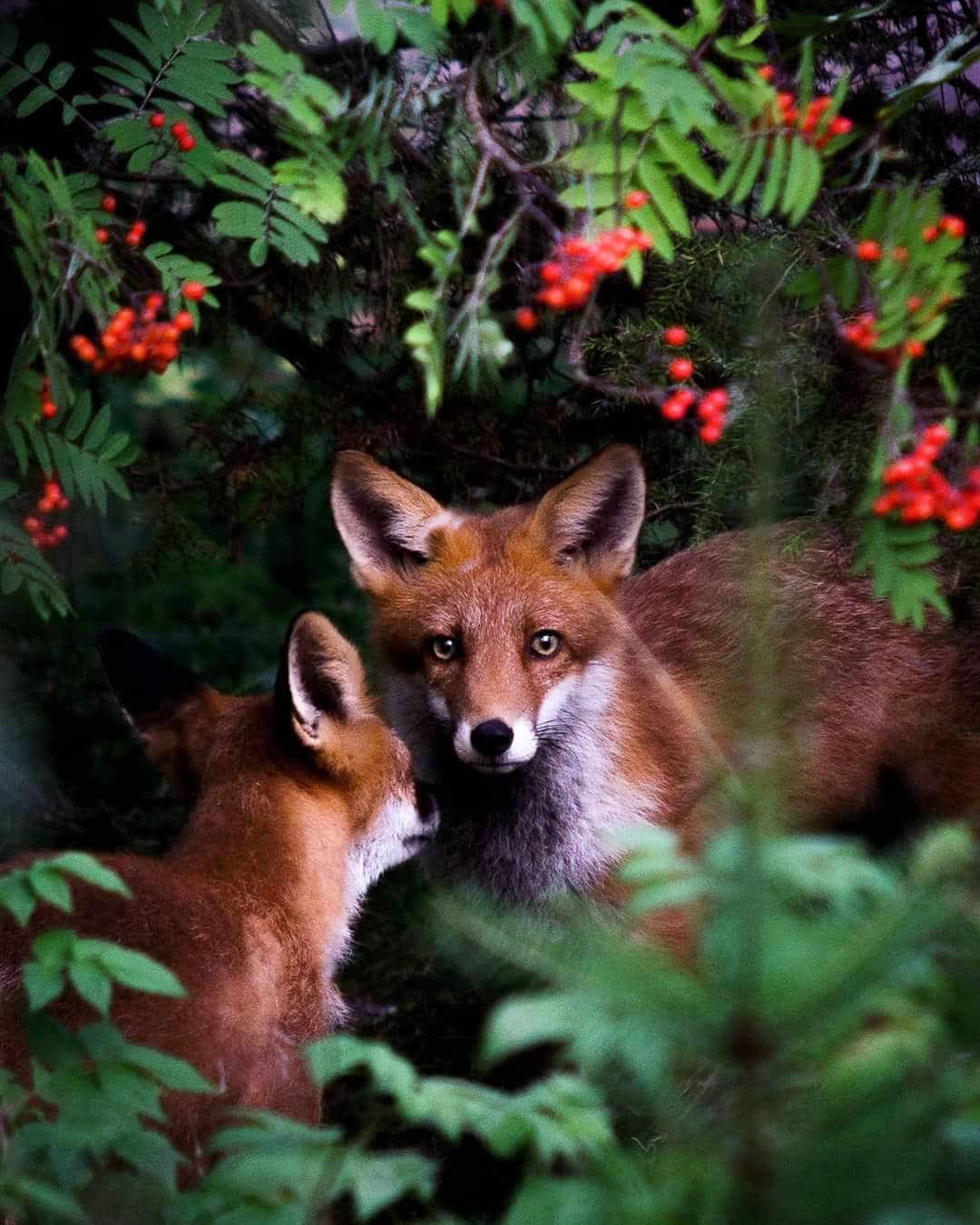Forests that like cooler climates are found largely in the northern hemisphere, far north of the equator. Forests are full of dead wood, which attracts all sorts of creatures. The forests that are found near the equator known as Tropical Rainforest.
Forest animals
Forests are havens for wildlife, including the weasel, which is small enough to chase small rodents such as mice and voles down their holes.
What sort of tree?
Forests in cooler climates are made up from two basic types of trees.
Deciduous trees have broad, flat leaves. They lose their leaves in winter
Coniferous trees don't lose their leaves in winter. They are called evergreens.
Forest plants
Forest floors are shady places and it can be hard for plants to grow. Plants such as foxgloves can sometimes be found in clearings.
Deciduous Forests
Deciduous trees lose their leaves in winter. These trees need weather patterns that are neither too hot nor too cold, and with seasons.
Layer on layer
Deciduous forests have two or three layers a canopy (treetops), sometimes a layer of shrubs, and then the low lying plants such as mosses, ferns, and spring flowers.
If conditions are right, mosses grow on the north side of a forest tree.
Springing to life
A forest appears to sleep in winter, but in spring it bursts into life. Buds open and ferns spread out to soak up the light.
When mature, a fern bud unrolls and the leaflets open out.
Land of plenty
A forest floor is littered with dead leaves and wood, and there are often plenty of nuts and berries, it's a perfect hunting ground for squirrels.
The grey squirrel will collect and store acorns and other seeds. Squirrels have busy tails because it helps to balance as it leaps from tree to tree.
Links in a chain
- Food chains connect a species with what it eats.
- Leaves act like solar panels to gather sunlight to make food
- Caterpillars and many other insects chew on leaves. That's their food
- Birds hunt caterpillars, especially in spring when they have chicks to feed
- Foxes prey on birds, small mammals, and other creatures
Maple leaf
A leaf is a tree's food factory In autumn, it begins to shut down.
Autumn colours
In the growing season, deciduous leaves appear green because of a chemical called chlorophyll. In autumn, the leaves turn yellow, brown, or red as the chlorophyll is destroyed.
Making an entrance
Woodpeckers use their beaks to dig out grubs and to make nest holes. They have amazingly long tongues to probe and seek out insects.
Woodpeckers have thick skulls to protect against the shock as they hammer into wood.
Trees as homes
Woodpeckers take two to three weeks to dig out a nest hole, into which the female lays several eggs. The hole is usually in a dead tree.
The Forest Floor
A deciduous forest floor is alive with a mighty army of insects and small creatures. There are rich pickings to be had for these animals.
Male stag beetles have nuge mandibles that form antlers. Mice nibble on seeds and berries. Mosses thrive on damp shady rocks and on tree trunks.
Salamanders breathe through their moist skin, so they have to stay damp all the time.
Woodlice eat rotting plants, fungi and their own poo!
A stag beetle lays its eggs on decaying tree stumps or roots. The larvae then eat the wood.
A millipede has a tough exoskeleton Some protect themselves by rolling into a ball.
Things that wriggle
Earthworms help to break soil down, taking it in at their mouth and digesting it in a short intestine. The worms droppings help to enrich the soil.
Prickly hogs
Hedgehogs snuffle along using their keen sense of smell to find such goodies as beetles, caterpillars, earthworms, snails, slugs, and spiders. European hedgehogs are most active at night, especially when the ground is wet and worms come to the surface.
Seeds
Trees have a variety of ways of spreading their seeds widely.
- Rowan trees produce seeds in berries that are eaten and so spread by birds.
- Poplar seeds grow on catkins. Hairs catch the breeze and they fly away.
- Sycamore seeds have wings that direct their fall away from the tree.
- Acorns are collected and buried by squirrels. Some will grow.
Shade lovers
Most plants need lots of sunlight to grow well, but some flourish in shade. These include ferns.
I'll have your food!
Some plants manage without light by stealing food instead of using sunlight to make food. Broom rape plants grow suckers that work into the roots of other plants.
Life in a log
Life as a larva
A stag beetle spends the first few years of its life as a larva. As an adult, it only survives for a few months.
A stag beetle to grow 8.5 cm (3¼) in length.
Coniferous Forests
Forest giants
Perfectly at home
Cone specialist
Most birds wait for pine cones to fall before eating the seeds, but the crossbill can prise open a conifer's cones with its cross-tipped beak.
Pins and needles
Conifers have needle-shaped leaves that stay on all year. Instead of growing flowers and fruits, they produce cones.
Conifer trees are often cone-shaped. This lets snow slide easily off the branches.
A cone's scales close in wet weather but open when it's dry, releasing the seeds.
Does it have antlers?
One of the largest coniferous forest residents is the moose. Only the males have antlers.
All moose have a flap of skin. a bell, hanging from their throat. Moose is the world's biggest deer. In Europe moose is called elk.
Wolves and wolverines
Larger predators such as wolves and wolverines are not often spotted in the wild. Thick fur allows them to survive the chilly winters of a coniferous forest.
Wolverines are also known as gluttons because of their large appetites.
Water babies
In summer-time, moose love to wade into lakes and ponds to feed on aquatic plants and to escape the clouds of biting flies that suck their blood.
Fantastic Forest Fungi
What is a mushroom?
Many fungi live underground. To produce more fungi, they push up mushrooms that send spores into the air.
Fairy rings
Some fungi are huge and lie like carpets underneath the forest floor. In clearings. mushrooms will sometimes grow around the edge of the unseen fungi in rings.
Making more fungi
Mushrooms and the other fun fruits do not make seeds. Instead they make tiny spores thot blow away in the wind and produce more fungi.
Is that a mushroom?
Not all mushrooms look like the mushrooms that you eat. There are many different types and they come in all shapes, sizes, and colours.
The fungus family
There are many types of fungi, some you may like, and others you may not.
- Penicillin: antibiotics made from fungi con cure diseases in humans
- Mould: when food rots it sometimes gets mould on it. This is a fungus
- Blue cheese: when you eat blue cheese. you are actually eating mould!
- Ringworm: some fungi cause diseases, such as this ringworm on the skin.
Cleaning up
Fungi are one of the world's natural cleaners. When a plant or animal dies, fungi help to break it down, helping to clear the forest from rotten things.
Live food
Some fungi live off the things that they live on, such as trees. They do not have stomachs, instead they release a liquid that digests food outside the body.
The world largest fungus covers an area the size of more than 1,600 football pitches.
Warning! Poison!
Some mushrooms are very poisonous. They are often brightly coloured to warn animals not to eat them. People often call poisonous mushrooms toadstools.
If mushrooms and toadstools didn't exist, the earth would be buried in several metres of rotten gunge and life on the planet would soon disappear.
Some poisonous mushrooms can kill a human if eaten.
Mushroom is the visible part of a large fungus that lives underground.
Winter Survival
The chill of winter brings less food and icy winds. Plants and animals have different techniques for surviving the changes.
To stay or go?
Some birds are perfectly at home in cold conditions. The male robin winters in England, while some females fly to a milder Spain. Come spring, they will head back.
Let's change colour
A number of animals change their coat in the winter. The stoat's coat turns white, for comouflage. A white stoat is known as an ermine.
Chilling out
A good way to survive winter is to hibernate. A hibernating animal isn't just asleep its body becomes cold and inactive, as though the animal is dead.
In hibernation a European dormouse's heart beats just once a minute.
A European dormouse spends just five months of the year out of hibernation.
Leaves to last
Holly and ivy can survive wintry conditions because their leaves have a thick waxy covering that protects them in both cold and dry weather.
The stoat has brown and white summer coat, with a black tip to its tail.
The great escape
Birds can't hibernate, but they can fly away and spend winter somewhere warmer. Many do this.
Some butterflies hibernate while others spend the winter in chrysalis form, emerging in the spring. Coniferous trees can survive areas where the winters may last eight months.
A hot bath
One group of Japanese macaques jump into natural hot springs to warm up in winter, though getting out can leave them a bit cold.
Life as a Japanese macaque
In the winter months, Japanese macaques grow a thicker coat. They are intelligent and sociable animals, living in troops of 20 to 30 individuals.
Macaques are also known as snow monkeys. The young learn to roll snowballs just for fun
The woodchuck and the hedgehog both hibernate.
Weird Woods
Not all evergreen trees have needle-shaped leaves, and not all broad-leaved trees shed their leaves. Bamboo is broad-leaved, but evergreen. Weird woods have some unusual residents, such as the Tasmanian sugar glider.
Bamboo forests
In parts of China, bamboos grow as tall as trees, although they are grasses. They are the fastest-growing plants in the world.
Pandas depend on bamboo forests for their survival.
No need for flight
Many of New Zealand's birds, like the kiwi, are flightless. The kiwi lives more like a hedgehog, rooting around on the forest floor.
Kiwi is flightless because of it has no natural predators.
Prehistoric!
The tree fern is a strange relic from the days of the dinosaurs. It is an evergreen tree.
Tree ferns were once a source of food for some dinosaurs.
Life in a tree
Eucalyptus leaves are poisonous, but one animal can stomach them, the koala. Special bacteria aid digestion.
Koalas spend most of their lives in eucalyptus trees, even sleeping up there! They feed on the leaves for about four hours each night.
Eucalyptus is broad leaved, but evergreen.
Seen by dinosaurs
With their rounded tops and stiff, upward-pointing leaves, monkey puzzle trees are related to trees that were viewed by dinosaurs. They are broad-leaved, but evergreen.


























0 Comments